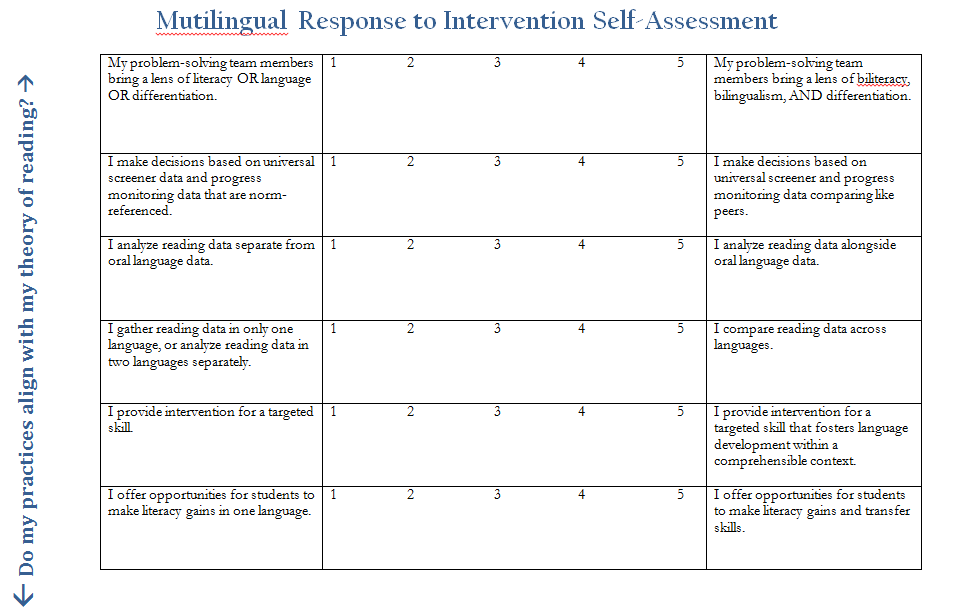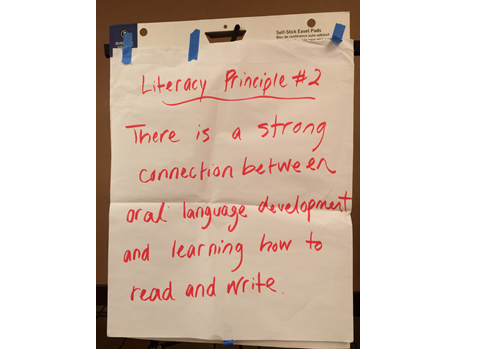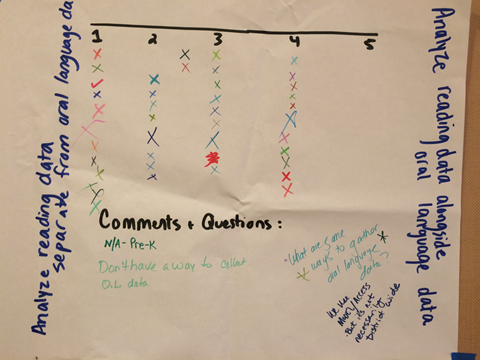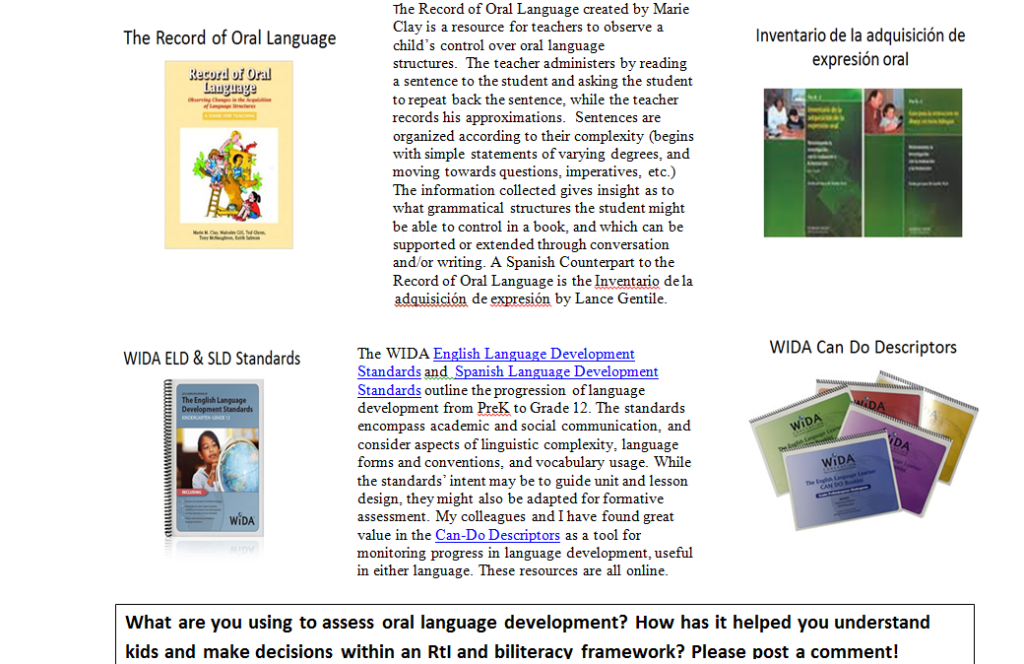RtI and Biliteracy: How can we gather data on oral language?
Last week I had the privilege of attending the TfB Summer Institute and leading a session: Intervention in a Biliteracy Framework. This post will spotlight one hot topic that arose from the session, and invite readers to chime in with their thinking.
Let’s face it: the term “RtI” and “intervention” carry a certain connotation, not always positive. Yet if you’re reading this post, chances are you recognize their importance. (After all, this is optional reading, and this is July!) Chapter 1 of Teaching for Biliteracy describes how a multilingual perspective embraces all of the child’s linguistic resources to achieve bilingualism and biliteracy. It is this same perspective that should guide our decisions around intervention! Participants in last week’s session used the self reflection below to consider some layers of an RtI System, and to what extent their practices apply a multilingual perspective.
One surprise that surfaced in the learning was around the use of oral language data in our decision-making around kids. Below is literacy principle #2 (Genesee, Lindholm-Leary, Saunders, & Christian, 2005, Krashen, 2004). We believe that a student’s language acquisition will impact the process of learning to read. We know we should think critically about the many language learners who appear “in the red” on our universal screener (see blog post: literacy processing and language development). We agree on the value in comparing student data with “like peers” who share similar language backgrounds. We see the importance of assessing oral language development and monitoring its progress. Yet despite our beliefs, see below how we rated ourselves on the spectrum of utilizing oral language data…
It seems to me there is a disconnect between our theory and practice. On one hand, we acknolwedge the role of oral language and literacy. On the other hand, we’re not always considering this data in conjunction. When asked to explain the disconnect, the group pointed to the need for tools and resources that allow us to gather information on oral language, in English and/or Spanish. Question: What are we using to observe and assess oral language development? I will respond to the question describing two tools I’m familiar with. I’ll then ask readers to please post a comment sharing their ideas.
About the Author: Emily Zoeller
Comments (4)
Comments are closed.






In terms of assessing oral language development, I have not been very consistent about using a formal assessment of any kind. Though my teaching partner and I use the WIDA standards to guide our expectations and understanding around what our lanuage learners can do in their primary language and how that skill/ability should then transfer to the second language, this is done mainly through observation and informal note-taking. The ACCESS scores have been useful to us, too, in terms of understanding the projectile of our English Language Learners’ acquisition of English across the domains.
As principal at a diverse elementary school I appreciate the reminder to consider always oral language as we engage in our own “RtI” conversations. We attempt to structure these conversations to identify strengths and areas of need, but without bringing language into our analysis, the conversation is incomplete. This past school year our Kindergarten team chose to focus on their students’ oral language development and growth throughout the year. They used an assessment similar to the Record of Oral Language to measure growth, and they observed an unmistakable connection between students’ oral language and literacy skills. They also noticed that when they explicitly scaffolded and taught academic language structures, their students were more likely to be able to read and write them. While these reflections may seem obvious to any educator who has a language acquisition background, they were important take-aways for this group of monolingual teachers. In addition, they opened up the door to having even more rich conversations about learning and (bi)literacy that are rooted in language.
We use the ACCESS for ELLs summative assessment from WIDA as our primary data source for language proficiency. This provides important data across the four domains of language for conversations around students who are struggling to progress in reading. Ensuring that this data is at the table when the student being discussed is an English Language Learner helps promote the multilingual perspective on literacy and RtI. The drawback with this is that the data is often antiquated because it is a yearly assessment with a 3-4 month wait-period to get results. We are excited to see what ACCESS 2.0 allows us to do in terms of having more relevant data on oral language proficiency for English Language Learners.
In my experience, what is often looked over is the role of first and second language proficiency in English dominant students in dual language immersion programs. Whereas research and experience have proven that English dominant students can successfully master reading and writing in both languages in a 90/10 program where all literacy and most oral language development takes place in the target language, Mrs. Zoeller’s question is particularly compelling when asked about English dominant students who struggle to show progress in target-language literacy in the 90/10 setting.
As educators we know that oral language and reading/writing skills are without a doubt linked. Also, as educators we have tools that we can and do use to assess children’s development in oral language and reading/writing. Personally, I have found a lot a value in both the ROL and El inventario. What I have found helpful with these two assessments is not only are they quick (little lost learning time), but they help identify different language structures that my students have under control in their oral language. What this helps me do is plan book introductions for individual and group lessons. For example, if a student struggles to produce a type of tense such as the subjunctive tense, this child will most likely struggle to not only read, but also write this tense.
What would be helpful to have would be detailed discussions around language. At times we seem to identify students as “ELL” or “non-ELL”. For most students this label leaves so much for us to know about kids. Within our RtI model I think it would be useful to develop tools that help us look more deeply at all the language and dialect resources that our children bring to their schooling.